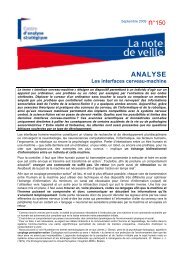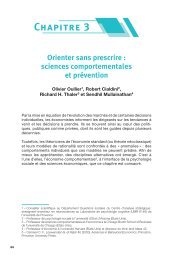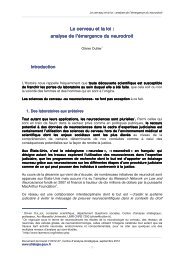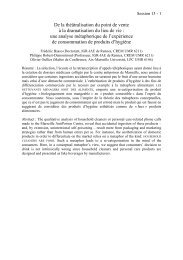Stability of rhythmic visuo-motor tracking does not ... - Olivier Oullier
Stability of rhythmic visuo-motor tracking does not ... - Olivier Oullier
Stability of rhythmic visuo-motor tracking does not ... - Olivier Oullier
Create successful ePaper yourself
Turn your PDF publications into a flip-book with our unique Google optimized e-Paper software.
Exp Brain Res (2008) 184:269–273DOI 10.1007/s00221-007-1180-0RESEARCH NOTE<strong>Stability</strong> <strong>of</strong> <strong>rhythmic</strong> <strong>visuo</strong>-<strong>motor</strong> <strong>tracking</strong> <strong>does</strong> <strong>not</strong> dependon relative velocityAymar de Rugy Æ <strong>Olivier</strong> <strong>Oullier</strong> ÆJean-Jacques TempradoReceived: 14 March 2007 / Accepted: 15 October 2007 / Published online: 1 November 2007Ó Springer-Verlag 2007Abstract It is well established that the in-phase pattern <strong>of</strong>bimanual coordination (i.e. a relative phase <strong>of</strong> 0°) is morestable than the antiphase pattern (i.e., a relative phase <strong>of</strong>180°), and that a spontaneous transition from antiphase toin-phase typically occurs as the movement frequency isgradually increased. On the basis <strong>of</strong> results from relativephase perception experiments, Bingham (Proceedings <strong>of</strong>the 23rd annual conference <strong>of</strong> the cognitive science society.Laurence Erlbaum Associates, Mahwah, pp 75–79,2001; Ecol Psychol 16:45–53, 2004; Advances in psychology135: time-to-contact. Elsevier, Amsterdam, pp421–442, 2004) proposed a dynamical model that consists<strong>of</strong> two phase driven oscillators coupled via the perceivedrelative phase, the resolution <strong>of</strong> which is determined byrelative velocity. In the present study, we specifically testbehavioral predictions from this last assumption during aunimanual <strong>visuo</strong>-<strong>motor</strong> <strong>tracking</strong> task. Different conditions<strong>of</strong> amplitudes and frequencies were designed to manipulateselectively relative phase and relative velocity. While theknown effect <strong>of</strong> phase and frequency were observed, relativephase variability was <strong>not</strong> affected by the differentconditions <strong>of</strong> relative velocity. As such, Bingham’s modelA. de Rugy (&)Perception and Motor Systems Laboratory,School <strong>of</strong> Human Movement Studies, Room 424,Building 26, University <strong>of</strong> Queensland,St Lucia, QLD 4072, Australiae-mail: aymar@hms.uq.edu.auA. de Rugy J.-J. TempradoUMR Mouvement et Perception (UMR 6152),CNRS and Université de la Méditerranée, Marseille, FranceO. <strong>Oullier</strong>Laboratoire de Neurobiologie Humaine (UMR 6149),Université de Provence and CNRS, Marseille, Franceassumption that instability in relative phase coordination isbrought about by relative velocity that affects the resolution<strong>of</strong> the perceived relative phase has been invalidated forthe case <strong>of</strong> <strong>rhythmic</strong> unimanual <strong>visuo</strong>-<strong>motor</strong> <strong>tracking</strong>.Although this <strong>does</strong> <strong>not</strong> rule out the view that relative phaseproduction is constrained by relative phase perception, themechanism that would be responsible for this phenomenonstill has to be established.IntroductionSince the seminal studies <strong>of</strong> Kelso (1981, 1984), the relativestability between different patterns <strong>of</strong> bimanualcoordination has been extensively studied to investigate theconstraints acting upon the coordination <strong>of</strong> interlimbmovement. The in-phase pattern <strong>of</strong> coordination (i.e. arelative phase <strong>of</strong> 0°) was typically found more stable thanthe antiphase pattern (i.e., a relative phase <strong>of</strong> 180°), andspontaneous transitions from antiphase to in-phase weretypically observed as the movement frequency was graduallyincreased.Although neuromuscular correlates <strong>of</strong> those behavioralprinciples have been clearly identified (e.g., Carson 2005;Carson and Kelso 2004; Swinnen 2002), similar principleswere also found under the sole influence <strong>of</strong> visual coupling,as in interpersonal coordination (Schmidt et al. 1990, 1998;Temprado and Laurent 2004; de Rugy et al. 2006) and inunimanual <strong>visuo</strong>-<strong>motor</strong> <strong>tracking</strong> <strong>of</strong> a movement on a screen(Wimmers et al. 1992; Stins and Michaels 2000; Buekerset al. 2000).This motivated Bingham and colleagues to conduct a set<strong>of</strong> studies showing that perception <strong>of</strong> the variability <strong>of</strong> therelative phase between two balls moving on a screen123
270 Exp Brain Res (2008) 184:269–273matches behavioral results: the antiphase pattern wasjudged more variable than the in-phase pattern, and relativephase was judged more variable as the movement frequencyincreased (Bingham et al. 1999, 2001; Zaal et al.2000). On the basis <strong>of</strong> those results, Bingham (2001,2004a, 2004b) proposed a dynamical model that capturesthe results <strong>of</strong> both behavioral and perception studies.Central to this model is the coupling <strong>of</strong> two phase drivenoscillators via the perceived relative phase, the resolution<strong>of</strong> which is determined by relative velocity. In the presentstudy, we specifically test behavioral predictions from thislast assumption <strong>of</strong> the model, i.e., that instability in relativephase coordination is brought about by relative velocitythat affects the resolution <strong>of</strong> the perceived relative phase.This was achieved by manipulating selectively relativephase and relative velocity during a unimanual <strong>visuo</strong>-<strong>motor</strong><strong>tracking</strong> task.Bingham’s model is as follows:€x i þ b _x i þ kx i ¼ c sinð/ j ÞP ij€x j þ b _x j þ kx j ¼ c sinð/ i ÞP ji ð1Þwhere x i and / i are the position and phase <strong>of</strong> oscillator i,respectively, and the dots de<strong>not</strong>e the first and secondderivatives. Each oscillator is driven by the perceivedphase <strong>of</strong> the other oscillator multiplied by a term Prepresenting perceived relative phase:P ji ¼ sign sinð/ i Þ sinð/ j Þþað _x i _x j ÞN t ð2ÞP (i.e. ± 1) is the sign <strong>of</strong> the product <strong>of</strong> the two driversincremented by a Gaussian noise term with a variance thatis proportional to the velocity difference between theoscillators.In the absence <strong>of</strong> noise, P = +1 ensures an in-phasepattern <strong>of</strong> coordination, whereas P = -1 ensures theopposite (antiphase) pattern. While the velocity differenceis minimal during the production <strong>of</strong> the in-phase pattern <strong>of</strong>coordination between oscillatory movements <strong>of</strong> similaramplitude (Fig. 1b1), it is oscillating at a maximal amplitudefor the antiphase behavior (Fig. 1b2); a noise term thatis function <strong>of</strong> this difference (Fig. 1c2) will therefore affectP (Fig. 1d2) and the stability <strong>of</strong> the resulting behavior. Asthe velocity signals increase with frequency, so do thevelocity difference and the resulting noise, leading to afurther increased variability <strong>of</strong> the behavior. Note that theuse <strong>of</strong> non-normalized velocity in Eq. 2 is crucial here,since normalizing velocity would prevent the increase invariability the model was precisely designed to reproduce.These features are illustrated in Fig. 2a together with predictionsfrom Bingham’s model in response to our selectivemanipulation <strong>of</strong> relative phase and relative velocity. Thisselective manipulation was achieved via the modulation <strong>of</strong>the amplitude <strong>of</strong> one <strong>of</strong> the two oscillations only: Bymultiplying the amplitude <strong>of</strong> one movement by three, thevelocity difference obtained during an in-phase behavior(Fig. 1b3) is similar to that <strong>of</strong> the antiphase behavior performedwith similar amplitudes (Fig. 1b2). According toBingham’s model, those two conditions should thereforeproduce similar variability pr<strong>of</strong>iles (Fig. 2a). Furthermore,the velocity difference obtained during an antiphase coordinationperformed with different amplitudes (Fig. 1c4) ishigher than that obtained with similar amplitudes (Fig. 1c2). According to Bingham’s model, the variability <strong>of</strong> thebehavior should therefore be higher in the former conditionas compared with the latter (Fig. 2a). If the mechanismsinvolved in the studied coordination are independent <strong>of</strong> therelative velocity, however, our manipulation <strong>of</strong> movementamplitude should have little effect on the behavior; i.e., theknown effects <strong>of</strong> phase and frequency should be observed,but different amplitudes should <strong>not</strong> affect relative phasevariability (Fig. 2b).We tested those predictions during a unimanual <strong>visuo</strong><strong>motor</strong><strong>tracking</strong> task that permitted to keep the amplitude <strong>of</strong>the participants’ movement constant while manipulatingsolely the amplitude and frequency <strong>of</strong> the target to track(either in-phase or antiphase).Materials and methodsSix participants (four males and two females, aged 21–28)volunteered for this experiment. All were right handed withnormal or corrected to normal vision. Participants werenaive to the purpose <strong>of</strong> the experiment. They all gaveinformed consent prior to experiment, which was approvedby the local ethics committee and conformed to the Declaration<strong>of</strong> Helsinki.Each participant sat in a chair 70 cm from a computerdisplay positioned at eye level. With their right hand,participants grasped a handle fixed to a rotating horizontalshaft (instrumented to record angular displacement at asampling rate <strong>of</strong> 100 Hz) adjacent to the ulna. Pronation–supination movement resulted in the higher part <strong>of</strong> thehandle to move right–left from the middle position definedby the vertical (forearm mid-prone).The angular displacement <strong>of</strong> the handle controlled byparticipants was displayed online on the screen as a linearhorizontal displacement <strong>of</strong> a white ball moving in the samedirection as the higher part <strong>of</strong> the handle. An amplitude A1<strong>of</strong> 3.4 cm (corresponding to an angular displacement <strong>of</strong> thehandle <strong>of</strong> 62°) was prescribed by two thin vertical linesbetween which the participants were required to oscillate.Four centimeters above the ‘‘handle’’ ball was a ‘‘target’’(also white) ball moving according to an imposed sinusoidalhorizontal displacement. The white balls (1.7 cmdiameter) were presented on a dark background. To ensure123
Exp Brain Res (2008) 184:269–273 271Fig. 1 a The positions (in arbitrary unit) <strong>of</strong> two oscillatory objectsfor the combinations <strong>of</strong> two conditions <strong>of</strong> relative phase [in-phase(IN) and antiphase (ANTI)] and amplitude (A1 same amplitudes; A2one oscillation has an amplitude <strong>of</strong> three times the other). Rows 1–4correspond to condition IN-A1, ANTI-A1, IN-A2, and ANTI-A2,respectively. b–d Corresponding components <strong>of</strong> the coupling functionthat only the stimulus displayed on the screen could beseen, the experiment was performed in the dark and participantswore soldering glasses. This visual display wasdesigned to be as close as possible to that reported in thestudies conducted by Bingham and colleagues on the perception<strong>of</strong> relative phase (Bingham et al. 1999, 2001; Zaalet al. 2000).Participants were instructed to synchronize their oscillation(handle ball) either in-phase (IN) or antiphase(ANTI) with the oscillation <strong>of</strong> the target dot. In the INcondition, the handle ball had to move in the same directionas the target ball, and in the ANTI condition, it had tomove in the opposite direction. While the amplitude <strong>of</strong> thehandle ball’s displacement was always prescribed at3.4 cm, the amplitude <strong>of</strong> the target’s displacement waseither 3.4 cm (condition A1) or three times 3.4 cm (i.e,10.2 cm, condition A2). Three frequencies were employed:in Bingham’s model (Eq. 2). b Relative velocity ð _x i _x j Þ; c product(prod) <strong>of</strong> the drivers incremented by a Gaussian noise with a varianceproportional to the velocity difference (i.e., prod ¼ sinð/ i Þsinð/ j Þþað _x i _x j ÞN t ; with a = 0.0015); d sign <strong>of</strong> prod (i.e., Pin Eq. 2)0.75, 1.25, and 1.75 Hz. After a few practice trials, theacquisition session consisted <strong>of</strong> five trials <strong>of</strong> 35 s performedin each <strong>of</strong> the 12 conditions [phase(2) 9 amplitude (2) 9 frequency (3)], presented in a fullyrandomized order.Continuous relative phase was determined in phasespace, i.e., the space spanned between position and velocityfor each oscillation. The angular velocity obtained by differentiation<strong>of</strong> angular position was normalized by dividingthe velocity signal by the mean frequency. Next, the phaseangles were computed for each sample <strong>of</strong> oscillatorymovement as the arctangent <strong>of</strong> the position and velocity.Mean circular relative phase w was then determined usingcircular statistics (Fisher 1993). To this end, the cosine andsine <strong>of</strong> the difference between the phase angle for thehandle and the target were averaged separately, and w wasobtained as the arctangent <strong>of</strong> their ratio (for more detail,123
272 Exp Brain Res (2008) 184:269–273Fig. 2 Predicted (a, b) andeffective (c) variability <strong>of</strong> therelative phase presented as afunction <strong>of</strong> frequency for thedifferent experimentalconditions <strong>of</strong> phase andamplitude. a Qualitativeprediction based on a variabilitythat scales with relative velocity(i.e., Bingham’s model). bQualitative prediction based ona variability that <strong>does</strong> <strong>not</strong>depend on relative velocity (i.e,the known effects <strong>of</strong> phase andfrequency only are displayed). cExperimental results (SDw).Plain lines represent the inphase(IN) and dashed lines theantiphase (ANTI) conditions,while dark lines representconditions <strong>of</strong> similar amplitudes(A1) and gray lines conditionsin which one oscillation has anamplitude <strong>of</strong> three times theother (A2). Error bars representthe standard deviationssee Russell and Sternad 2001). A measure <strong>of</strong> dispersion <strong>of</strong>circular relative phase, uniformity U, was calculatedaccording to Fisher (1993). As this measure is bounded by0 and 1 and is nonlinear with respect to the distributionaround the mean relative phase angle, it is converted into ameasure <strong>of</strong> dispersion SDw that varies approximately linearlybetween 0 and infinity according to:SDw ¼ ð 2 log e UÞ 1=2As in the linearly computed standard deviation measurehigh values <strong>of</strong> SDw de<strong>not</strong>e high variability, and low valuesindicate low variability.Relative phase variability SDw was averaged over thefive trials performed under the same experimental condition,and analyzed using three-way repeated measuresANOVA (phase 9 amplitude 9 frequency). When a significanteffect was obtained, the proportion <strong>of</strong> totalvariability attributable to the factor concerned was reportedas the value <strong>of</strong> partial eta-squared (g 2 ) (see Pierce et al.2004, for information about partial eta-squared measures).ResultsFigure 2c shows that the variability <strong>of</strong> the relative phasewas higher for the antiphase than for the in-phase pattern <strong>of</strong>coordination; that this variability increased with the frequency<strong>of</strong> movement; and that this increase was higher forthe antiphase than for the in-phase pattern <strong>of</strong> coordination.The three-way repeated measures ANOVA(phase 9 amplitude 9 frequency) conducted on SDwrevealed a strong effect for the phase (F(1, 5) = 30.24,P = 0.003, g 2 = 0.86), for the frequency (F(2, 5) = 23.06,P = 0.006, g 2 = 0.92), and a significant interaction betweenthem (F(1, 5) = 23.19, P = 0.006, g 2 = 0.92). No effect,however, was found for the amplitude (F(1, 5) = 0.05,P = 0.83) or for the other interactions (all F \ 0.65 andP [ 0.56). Figure 2c confirms that our manipulation <strong>of</strong>amplitude had little effect on the behavior, and that theobtained variability pr<strong>of</strong>iles correspond to a coordinationmechanism that <strong>does</strong> <strong>not</strong> depend on relative velocity(Fig. 2b) rather than on the coordination mechanism proposedin Bingham’s model (Fig. 2a).DiscussionBingham (2001; 2004a, b) proposed a perceptually drivendynamical model <strong>of</strong> bimanual coordination that consists<strong>of</strong> two phase driven oscillators coupled via the perceivedrelative phase, the resolution <strong>of</strong> which deteriorates as afunction <strong>of</strong> relative velocity. In the present study, we123
Exp Brain Res (2008) 184:269–273 273specifically test behavioral predictions from this lastassumption, which is implemented Eq. 2 with a noiseterm that is proportional to the relative velocity. Therationale for this was tw<strong>of</strong>old: first the noise term inEq. 2 was supposed to reflect known sensitivities to thedirection <strong>of</strong> optical velocities (De Bruyn and Orban1988; Snowden and Braddick 1991). And second,because relative velocity is higher for antiphase than forin-phase coordination and increases with frequency, itsmagnitude already matches variability results <strong>of</strong> bothbehavioral and perception experiments. In the absence <strong>of</strong>influence <strong>of</strong> neuromuscular coupling between hands forour unimanual case, and while the <strong>motor</strong> component <strong>of</strong>the task was carefully kept constant (because theamplitude <strong>of</strong> the movement to perform was constant, the<strong>motor</strong> command had to be virtually the same for thedifferent conditions <strong>of</strong> relative phase and target amplitudeperformed at the same frequency), our experimentwas designed to promote as much as it possibly couldthe influence <strong>of</strong> the a perceptual component as proposedin Bingham’s model. Yet, we failed to observe aninfluence <strong>of</strong> relative velocity on the variability <strong>of</strong> thebehavior, and must conclude that the coupling termproposed in Bingham’s model <strong>does</strong> <strong>not</strong> reflect the couplingthat operates in <strong>rhythmic</strong> <strong>visuo</strong>-<strong>motor</strong> <strong>tracking</strong>.Although this <strong>does</strong> <strong>not</strong> rule out the view that relativephase production is constrained by relative phase perception,the mechanism that would be responsible for thisphenomenon still has to be established.Acknowledgments This work was founded by The AustralianResearch Council, a University <strong>of</strong> Queensland Travel Award, andsupport from the UMR Mouvement et Perception, CNRS-Universitéde la Méditerranée, Marseille, France.ReferencesBingham GP (2001) A perceptually driven dynamical model <strong>of</strong><strong>rhythmic</strong> limb movement and bimanual coordination. In:Proceedings <strong>of</strong> the 23rd annual conference <strong>of</strong> the cognitivescience society. Laurence Erlbaum Associates, Mahwah, pp 75–79Bingham GP (2004a) A perceptually driven dynamical model <strong>of</strong>bimanual <strong>rhythmic</strong> movement (and phase perception). EcolPsychol 16:45–53Bingham GP (2004b) A<strong>not</strong>her timing variable composed <strong>of</strong> statevariables: phase perception and phase driven oscillators. In:Hecht H, Savelsbergh GJP (eds) Advances in psychology 135:time-to-contact. Elsevier, Amsterdam, pp 421–442Bingham GP, Schmidt RC, Zaal FT (1999) Visual perception <strong>of</strong> therelative phasing <strong>of</strong> human limb movements. Percept Psychophys61:246–258Bingham GP, Zaal FT, Shull JA, Collins DR (2001) The effect <strong>of</strong>frequency on the visual perception <strong>of</strong> relative phase and phasevariability <strong>of</strong> two oscillating objects. Exp Brain Res 136:543–552Buekers MJ, Bogaerts HP, Swinnen SP, Helsen WF (2000) Thesynchronization <strong>of</strong> human arm movements to external events.Neurosci Lett 290:181–184Carson RG (2005) Neural pathways mediating bilateral interactionsbetween the upper limbs. Brain Res Brain Res Rev 49:641–662Carson RG, Kelso JA (2004) Governing coordination: behaviouralprinciples and neural correlates. Exp Brain Res 154:267–274de Bruyn B, Orban GA (1988) Human velocity and directiondiscrimination measured with random dot patterns. Vision Res28:1323–1335de Rugy A, Salesse R, <strong>Oullier</strong> O, Temprado JJ (2006) A neuromechanicalmodel for interpersonal coordination. Biol Cybern94:427–443Fisher NI (1993) Statistical analysis <strong>of</strong> circular data. CambridgeUniversity Press, CambridgeKelso J (1981) On the oscillatory basis <strong>of</strong> movement. Bul PsychonSoc 18:63Kelso JAS (1984) Phase transitions and critical behavior in humanbimanual coordination. Am J Physiol Regul Integr Comp Physiol15:R1000–R1004Pierce CA, Block RA, Aguinis H (2004) Cautionary <strong>not</strong>e <strong>of</strong> reportingeta-squared values from multifactor ANOVA designs. EducPsychol Meas 64:916–924Russell DM, Sternad D (2001) Sinusoidal <strong>visuo</strong><strong>motor</strong> <strong>tracking</strong>:intermittent servo-control or coupled oscillations? J Mot Behav33:329–349Schmidt RC, Bienvenu M, Fitzpatrick PA, Amazeen PG (1998) Acomparison <strong>of</strong> intra- and interpersonal interlimb coordination:coordination breakdowns and coupling strength. J Exp PsycholHum Percept Perform 24:884–900Schmidt RC, Carello C, Turvey MT (1990) Phase transitions andcritical fluctuations in the visual coordination <strong>of</strong> <strong>rhythmic</strong>movements between people. J Exp Psychol Hum PerceptPerform 16:227–247Snowden RJ, Braddick OJ (1991) The temporal integration andresolution <strong>of</strong> velocity signals. Vision Res 31(5):907–914Stins JF, Michaels CF (2000) Stimulus-response compatibility forabsolute and relative spatial correspondence in reaching and inbutton pressing. Q J Exp Psychol A 53:569–589Swinnen SP (2002) Intermanual coordination: from behaviouralprinciples to neural-network interactions. Nat Rev Neurosci3:348–359Temprado JJ, Laurent M (2004) Attentional load associated withperforming and stabilizing a between-persons coordination <strong>of</strong><strong>rhythmic</strong> limb movements. Acta Psychol (Amst) 115:1–16Wimmers RH, Beek PJ, van Wieringen PCW (1992) Phase transitionsin <strong>rhythmic</strong> <strong>tracking</strong> movements: A case <strong>of</strong> unilateral coupling.Hum Mov Sci 11:217–220Zaal FT, Bingham GP, Schmidt RC (2000) Visual perception <strong>of</strong> meanrelative phase and phase variability. J Exp Psychol Hum PerceptPerform 26:1209–1220123








